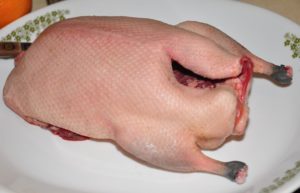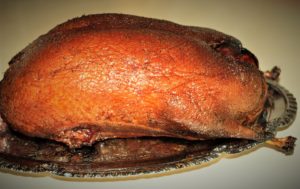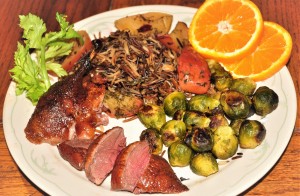Photography courtesy of Lowell Washburn, all rights reserved.
Regal Canvasback Remains at Pinnacle of Fine Dining
The end was in sight. With only a handful of days remaining, the 2017 Iowa duck season was winding down. To make matters even worse, the southbound migration through northern Iowa had long since passed. Stale, refuge-oriented mallards and a few stragglers of other species was all that was left. In spite of the dismal outlook, gusty northwest winds had made it impossible to sleep in. No matter how pathetic the numbers, there was always a chance of putting one more duck dinner on the table before things shut down for good.
As it turned out, the decision to go duck hunting was a good one. There was no big flight, of course, but there was a thin trickle of ducks. With a brace of bluebills and two drake redheads already in the bag, I was feelin’ good. But one thing was missing. Although the bulk of my decoys were high visibility, brightly colored drake canvasbacks, that species was noticeably absent. The King of Ducks had yet to make an appearance. The situation changed abruptly when around 8 o’clock, I spotted a lone ‘can rocketing downwind. I don’t think the bird saw the decoys until it had passed my location. Once it did notice the spread, the duck made a wide arc and came powering back toward my counterfeit look alikes. Arriving seconds later, the bird presented an easy shot.
Bagging a prime canvasback is always a stellar event; the pinnacle experience of American waterfowling. In the time honored, tradition steeped world of duck hunting, no single species is more historically or culturally significant. During the 1800s, canvasbacks were the mainstay of commercial gunning enterprises which, during its seventy-year heyday, provided tens of thousands of Americans with a ready source of high quality protein. Even in those days of unfathomable abundance, the famed canvasback was prized above all other fowl. At bustling urban markets, fresh canvasbacks fetched two to three times the price of any other species – including the highly popular redhead and mallard ducks.
Nowhere was the canvasback craze carried to greater extremes than on the eastern seaboard’s Chesapeake Bay. It was here that mind-boggling concentrations of ‘cans gathered each winter to feed on the succulent roots and tubers of wild celery; a diet that earned the species’ its legendary reputation for unrivaled table quality. In the Eastern cultural hubs of Baltimore, Philadelphia, or Washington D.C. roast canvasback was the first-choice entree for the tables of the elite. Whether served at state dinners or featured on the gilded menus of the finest hotels; the noble canvasback was the last word in fine dining.
The canvasback’s culnary standing has not diminished over time. Today, it remains the absolute Gold Standard of gourmet dining.
Initial Preparation: Bringing a prime canvasback [or any other duck] to bag is merely the first step of a journey that ends at the table. If the regal canvasback truly is the King of Ducks, then it must be treated as such. To begin with, the bird should be handled with the utmost respect. That means keeping it dry and keeping it clean. In order to achieve their flavorful potential, canvasbacks must always be plucked whole; never ever skinned or breasted– a barbaric practice that is as wasteful as it is disgusting 
In order to achieve maximum tenderness, canvasbacks should be aged [35 to 40 degrees is perfect] for a minimum of three to five days before roasting. Regardless of cooking method, canvasbacks should be served rare [or for more squeamish diners] no more than medium-rare. Anything beyond that is guaranteed to reduce both appearance and quality of the presentation. It takes real talent to mess up a fat canvasback; overcooking is the fast track to achieving that goal.
When cooking day arrives, allow duck to warm to room temperature. For seasoning, I usually keep it as simple as salt and pepper. For a spicier entree, I’ll occasionally use something like a Cajun rub or Durkee’s Six Pepper. I leave the body cavity empty. A properly aged canvasback is amazingly easy to prepare and should always be cooked hot. By hot, I mean an oven heated to 450 degrees. A lot of ovens won’t get that hot, but most will make it to 400 or so if you give them time to get there. 400 degrees works fine.
Whether prepared in a roaster or on a grate, I prefer to cook canvasbacks all by themselves. I’m not saying that cooking ducks with wild rice or bread dressing isn’t good; it is. It’s just that putting the birds by themselves is what works best for me.
Most old time, ‘Down East’ duck dinners included servings of wild rice, bread dressing, oyster dressing, stuffed clams, or crab cakes. I dearly love them all and wouldn’t think of eating canvasback duck without at least one of those sides. Speaking of side dishes, roast canvasback represents a signature moment in gourmet dining, and you’ll want to go the extra mile. No offense, but Uncle Ben definitely needs to sit this one out. Instead of prefab box mixes or those smothering cream of mushroom concoctions, try something better. Pull all the stops and thrill guests with servings of long grained Minnesota wild rice, fresh baked oyster dressing, or crab cakes prepared in your own kitchen.
Into the Fire: The canvasback is a very large duck. The one I bagged last week, for example, was just ¼ oz. shy of 3 pounds. But in spite of their size, cooking times are amazingly short — assuming that your oven is hot. In most cases, 18 to 20 minutes will bring ducks to rare, while 20 to 25 minutes or so will bring them to medium-rare. Keep in mind that not all oven dials or meat thermometers are created equal. Suggested cooking times are approximate; not absolute.
Once they’re removed from the oven, ducks should be rested for 8 to 10 minutes before carving. Don’t forget that ducks will continue to “cook” as they rest. That’s one lesson I’ve learned the hard way – and on more than one occasion. Trust me. Nothin’ dampens a party like a dry, fully cooked duck!
Taking it Outside: There are other excellent cooking methods, and I enjoy preparing all species of waterfowl in outside covered grills. Utilizing indirect heat, I bank coals on opposite sides of the kettle and shoot for an initial high temp of around 400 degrees. The difference between this method and the indoor oven is that, although grill temperatures start high, the heat will steadily diminish during cooking. But since cooking times are relatively short with ducks, this decrease is much less of a consideration than when cooking larger birds like giant Canada geese or wild turkeys. For heat, I prefer to mix charcoal with chunks of dry apple or mesquite. In this instance, we are simply cooking; not smoking the meat. Milder woods, like apple, will impart a light smokiness without overpowering the duck’s natural flavor. Depending on variables like wind speed and ambient temperature, outdoor cooking times will usually approximate those of indoor ovens – more or less. I usually begin testing ducks after 20 minutes or so and remove from the grill the minute — no, the second — juices begin turning from blood red to pink. Remember that it’s the same as in your kitchen: super-heated birds will continue cooking after they’ve left the grill.
Once your duck has rested, it’s time to dish up the sides, carve your bird and start the feast. If things went according to plan, the skin will be slightly crisped: the meat will be medium rare and melt in your mouth juicy. Wild or domestic, there is simply no other meat that can hold a candle to properly prepared canvasback duck – it’s that good. Your first incredible, flavor filled bite is all that’s needed to provide a reminder of why the regal canvasback has always been, and will forever be, the undisputed King of Ducks. Long live the King!




 Tom Cope
Tom Cope Sue Wilkinson
Sue Wilkinson Susan Judkins Josten
Susan Judkins Josten Rudi Roeslein
Rudi Roeslein Elyssa McFarland
Elyssa McFarland Mark Langgin
Mark Langgin Adam Janke
Adam Janke Joe Henry
Joe Henry Kristin Ashenbrenner
Kristin Ashenbrenner Joe Wilkinson
Joe Wilkinson Dr. Tammy Mildenstein
Dr. Tammy Mildenstein Sean McMahon
Sean McMahon